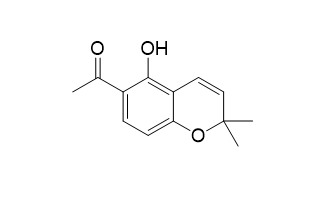Demethylisoencecalin
Demethylisoencecalin has antihyperglycemic activity.
Inquire / Order:
manager@chemfaces.com
Technical Inquiries:
service@chemfaces.com
Tel:
+86-27-84237783
Fax:
+86-27-84254680
Address:
1 Building, No. 83, CheCheng Rd., Wuhan Economic and Technological Development Zone, Wuhan, Hubei 430056, PRC
Providing storage is as stated on the product vial and the vial is kept tightly sealed, the product can be stored for up to
24 months(2-8C).
Wherever possible, you should prepare and use solutions on the same day. However, if you need to make up stock solutions in advance, we recommend that you store the solution as aliquots in tightly sealed vials at -20C. Generally, these will be useable for up to two weeks. Before use, and prior to opening the vial we recommend that you allow your product to equilibrate to room temperature for at least 1 hour.
Need more advice on solubility, usage and handling? Please email to: service@chemfaces.com
The packaging of the product may have turned upside down during transportation, resulting in the natural compounds adhering to the neck or cap of the vial. take the vial out of its packaging and gently shake to let the compounds fall to the bottom of the vial. for liquid products, centrifuge at 200-500 RPM to gather the liquid at the bottom of the vial. try to avoid loss or contamination during handling.
Appl. Sci.2020, 10(16),5482.
J Appl Biol Chem.2024, 67:39,281-288.
World J Microbiol Biotechnol.2024, 40(9):265.
Int J Mol Sci.2024, 25(23):12733.
Rep.Grant.Res.,Asahi Glass Foun.2023, No.119.
J of l. Chroma.&Related Tech2020, 43(11-12):414-423.
Molecules.2022, 27(7):2093.
Comput Biol Chem.2019, 83:107096
Chin J Appl. Physiol.2019, 35(3):283-288
Int J Mol Sci.2023, 24(14):11496.
Related and Featured Products
Molecules, 2017 Feb 14;22(2):289
Anti-Hyperglycemic Activity of Major Compounds from Calea ternifolia[Pubmed:
28216594]
Demethylisoencecalin (1) and caleins A (4) and C (5) (3.16-31.6 mg/kg, p.o.), the major components from an infusion of Calea ternifolia controlled postprandial glucose levels during an oral sucrose tolerance test (OSTT, 3 g/kg) in normal and nicotinamide/streptozotocin (NA/STZ, 40/100 mg/kg) hyperglicemic mice. The effects were comparable to those of acarbose (5 mg/kg). During the isolation of 1, 4, and 5, four additional metabolites not previously reported for the plant, were obtained, namely 6-acetyl-5-hydroxy-2-methyl-2-hydroxymethyl-2H-chromene (3), herniarin (6), scoparone (7), and 4',7-dimethylapigenin (8). In addition, the structure of calein C (5) was confirmed by X-ray analysis. Pharmacological evaluation of the essential oil of the species (31.6-316.2 mg/kg, p.o.) provoked also an important decrement of blood glucose levels during an OSTT. Gas chromatography coupled with mass spectrometry (GC-MS) analysis of the headspace solid phase microextraction (HS-SPME)-adsorbed compounds and active essential oil obtained by hydrodistillation revealed that chromene 1 was the major component (19.92%); sesquiterpenes represented the highest percentage of the essential oil content (55.67%) and included curcumene (7.10%), spathulenol (12.95%) and caryophyllene oxide (13.0%). A suitable High Performance Liquid Chromatography (HPLC) method for quantifying chromenes 1 and 6-hydroxyacetyl-5-hydroxy-2,2-dimethyl-2H-chromene (2) was developed and validated according to standard protocols.



